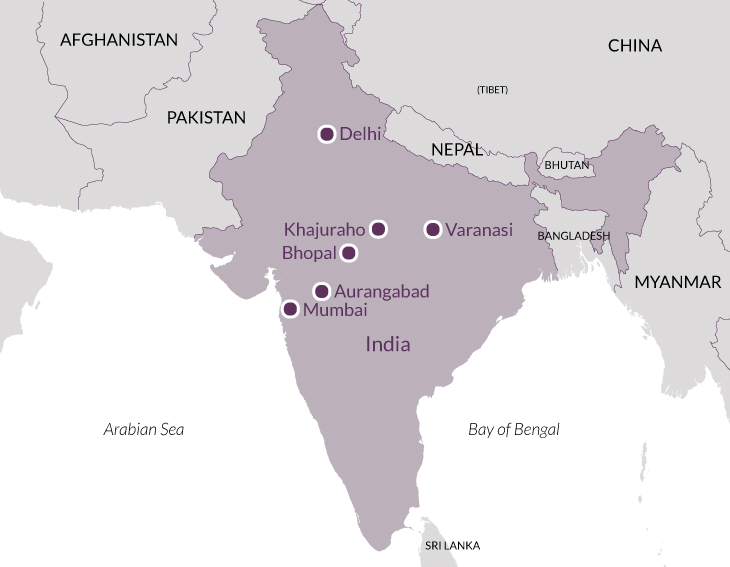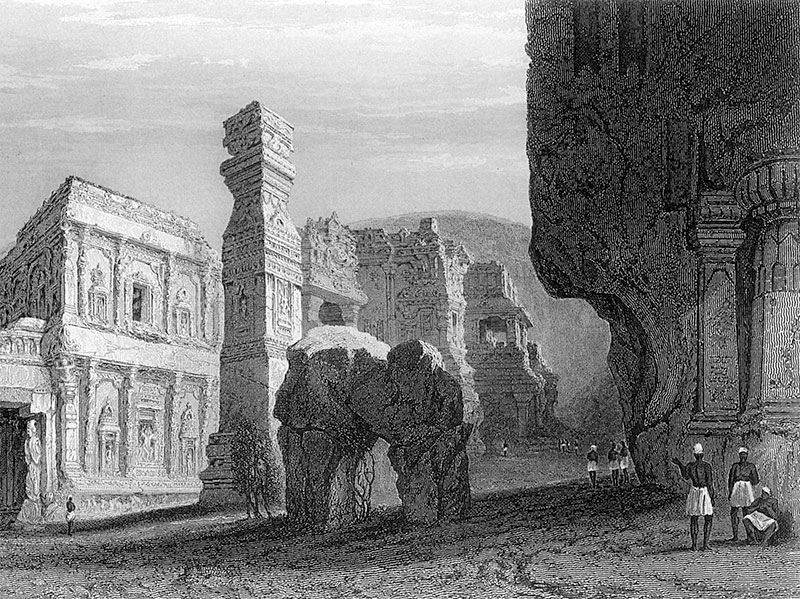Overview
‘The sacredness of India haunts me like a passion.’ So declared that great proconsul Lord Curzon just over a century ago. To this day the notion of India as a specially sanctified space continues to shape but perhaps also to distort our image of the subcontinent, thanks in part to the Beatles, the Guru Maharishi and the Swinging Sixties. But what really sets India apart from other exotic corners of the globe is not so much its religiosity as the sheer abundance and variety of religious expression to be found there, together with the remarkable art and architecture it has generated.
It is through the visual arts that the religious impulse finds its finest expression, and in India that expression extends over a period of some 3,500 years, moving from the snake- , tree- and fertility-goddess-worship of the original forest dwellers right through to the present. This span of time encompasses the advent of the Aryan pastoralists with their Vedic gods; the challenges to Brahmanical authority by the founders of Buddhism and Jainism; Emperor Ashoka’s unifying imperial dharma; the counter-reformation of devotional Hinduism and the cults of Shiva, Vishnu and Krishna; and the advance of Islam in both Sufic and militant form – to say nothing of Zoroastrianism, Sikhism, Christianity and even Judaism.
This ambitious and varied tour of India takes you on a journey through its very heartland which includes almost a dozen of India’s most remarkable religious sites, many of them on the World Heritage list. But it must be stressed that this is not a religious tour per se. Its object, quite simply, is to explore and, above all, enjoy India’s varied forms of religious experience in their proper context: not in museums and galleries but in those theatres where they have found their highest expression, both in terms of religious practice and artistic activity, whether beside the bathing ghats at Varanasi, the City of Light (otherwise known as Benares and Kashi), the finely carved temples at Khajuraho with their Tantric erotic carvings (yet to be fully understood), the ancient and austere rock-cut caves and temples at Ajanta, Ellora and Elephanta, or the sublime artistry of the great Buddhist stupa complex at Sanchi.
Day 1
Delhi. The tour begins in Delhi with a lecture and lunch in the hotel restaurant at c. 12.00 noon. (Flights from London are not included. Your room is available from 2.00pm on 14th March - see practicalities.) In the afternoon, visit the towering minaret and mosque at Qutb Minar, site of the first Islamic city of Delhi, established in 1193 on the grounds of a defeated Rajput fort. Overnight Delhi.
Day 2
Delhi to Varanasi. Fly to Varanasi (SpiceJet) in the morning. Afternoon walk through the old city and a boat ride on the holy Ganges at sunset to witness the Aarti ritual. This fire offering, which dates back to the time of the Buddha himself and was revived in the 19th century, is a daily blessing ceremony and a central element of the religious life of this sacred city. First of two nights in Varanasi.
Day 3
Sarnath, Varanasi. Sarnath is where the Buddha preached his first sermon and remains an active Buddhist centre. The Dhamek stupa in the Deer Park marks the spot where the Buddha sat to preach. The Sarnath museum houses the Ashokan lion capital, the symbol of modern India since independence. Afternoon visit to the Bharat Kala Bhavan, the university museum.
Day 4
Varanasi to Khajuraho. An early morning boat ride to witness the morning prayers and ablutions of the devout is followed by a walk among the sacred temples and holy ponds of the south part of the city, near Assi Ghat. Breakfast on the ghats (stepped embankments). Fly to Khajuraho via Agra (AirIndia) in the afternoon. First of three nights in Khajuraho.
Day 5
Khajuraho. In the morning, visit the Jain temples in the eastern group. The Parasnath Temple is conspicuous for its absence of erotic depictions. After lunch, visit the spectacular western group of temples built during the Chandela Rajput dynasty, famous for the beautifully carved erotic scenes. The awe-inspiring 11th-cent. Kandariya Mahadev Temple is one of the finest examples of North Indian temple architecture, richly embellished with sensuous sculptures depicting the god’s heavenly abodes. Nearby, the Jagadambi Temple contains excellent carvings of Vishnu. Afterwards visit the southern group of temples.
Day 6
Khajuraho. Full day at leisure. Optional excursions can be arranged.
Day 7
Khajuraho to Orchha. Drive to Orchha (c. 5 hours). Located close to the Betwa River on dramatic rocky terrain, Orchha’s former glory as capital of the Bundela kings is evident in the multi-chambered Jehangir Mahal with lapis lazuli tiles and ornate gateways. The Raj Mahal palace contains some beautiful murals with religious and secular themes. Elegant Royal Chhatris (cenotaphs) line the ghats of the Betwa. Overnight Orchha.
Day 8
Orchha to Bhopal. Drive to Jhansi and take an express train (c. 4 hours) to Bhopal in the morning. Arrival at the hotel c. 3.00pm. Some free time in the afternoon. First of two nights in Bhopal.
Day 9
Sanchi, Vidisha. Remotely located in open, hilly and sparsely populated countryside, Sanchi is one of the treasures of India and a unesco heritage site. On top of a hill with lovely views all around, the site was supposedly founded by the Great Ashoka. The 2nd-cent. ad stupa with stone railings and four magnificently elaborately carved gateways survives almost intact. Nearby Vidisha was an important Hindu centre under the Gupta dynasty as seen in the majestic carving of Varaha, the boar incarnation of Vishnu.
Day 10
Bhopal, Mumbai, Aurangabad. Early morning flight to Mumbai. The Dr Bhau Daji Lad City Museum (built 1885) was formerly known as the Victoria & Albert and is the oldest museum in Mumbai. Its collection explores the city’s distinctive communities and their respective religious practices. Fly in the afternoon to Aurangabad for two nights.
Day 11
Ajanta. Cut into the volcanic lava of the Deccan plateau, the Buddhist caves at Ajanta were first excavated around the 2nd cent. bc. A later group of caves was built during the Gupta era in the 5th–6th cent. ad before the site was abandoned in the 7th century in favour of Ellora. Celebrated for their fine statuary and the refined wall paintings, they are often considered one of the greatest achievements in Indian art.
Day 12
Ellora, Mumbai. With their uninterrupted sequence spanning four centuries, the caves and rock-cut temples at Ellora are both artistic masterpieces and technological achievements. The various monasteries dedicated to Buddhism, Jainism and Brahmanism also attest to the religious tolerance which prevailed under the Rashtrakuta dynasty. The impressive rock-cut, monolithic Kailashanatha Temple marks the transition between rock-cut and structural architecture, which took place around the 8th century across the Deccan. Fly to Mumbai in the late afternoon for two nights.
Day 13
Mumbai. In the morning, take a privately chartered boat to Elephanta Island. The largest of the two groups is dedicated to Lord Shiva. The relief panels depict the god in various forms. The central Trimurti image, or three-headed Shiva, is said to represent the three aspects of the deity and considered a masterpiece of Gupta art.
Day 14
Mumbai. Transfers are arranged to Mumbai airport for your onward journey.
Price – per person
Two sharing: £6,430. Single occupancy: £7,660.
Included
Arrival and departure airport car transfers; air travel (economy class) on flights with Jet Airways: Delhi to Varanasi (Boeing 737–800), Varanasi to Khajuraho (Boeing 737–800), Bhopal to Mumbai (Boeing 737–800) and Mumbai to Aurangabad (ATR72); travel by private air-conditioned coach and one journey by train (in the best class available); accommodation as described below; breakfasts, 11 lunches (including 1 packed lunch) and 9 dinners; beer, water, soft drinks and coffee at lunch plus wine at dinner; all admissions; all tips; all taxes; the services of the lecturer and tour manager and local guides.
Flights
Flights from London to Delhi and Mumbai to London are not included in the price of the tour. We will send the recommended flight options when they are available to book, towards the end of March 2019, and ask that you make your own flight reservation. The cost of a World Traveller (economy) seat with British Airways at the time of going to press is c. £550.
Visas
Required for most foreign nationals, and not included in the tour price. We advise you of the process.
Accommodation
The Taj Mahal, Delhi: a modern and comfortable hotel ideally situated in the heart of Lutyens’s Delhi. The Taj Gateway Ganges, Varanasi: a large, functional yet comfortable 4-star hotel with contemporary touches to the rooms; located close to the centre but removed from the bustle. The Lalit Temple, Khajuraho: a modern hotel within walking distance of the main site, rooms are spacious with large windows overlooking the pool or garden. Hotel Amar Mahal, Orchha: the most basic of the hotels on the tour, this 3-star equivalent is conveniently located and adequately equipped. The Jehan Numa Palace, Bhopal: a former royal residence on the edge of the city with gardens, verandas and a pool. Bedrooms vary but all are comfortable and well equipped. Vivanta Aurangabad, Aurangabad: a pleasant hotel set amid well-tended gardens. The rooms are comfortable, with private balconies. The Taj Mahal Palace, Mumbai: an iconic landmark and a masterpiece of Indo-Saracenic architecture, comfortable, centrally located and with excellent service.
How strenuous?
A good level of fitness is essential. Unless you enjoy entirely unimpaired mobility, cope with everyday walking and stair-climbing without difficulty and are reliably sure-footed, this tour is not for you. Uneven ground and irregular paving are standard. Sure-footedness is essential to board the river boats. Unruly traffic and the busy streets of larger cities require vigilance. There are some fairly steep ascents to hilltop forts and temples and numerous steps in Ajanta and Ellora. There are 2 long coach journeys during which facilities are limited and may be of poor quality. Most sites have some shade but the Indian sun is strong, even in the cooler seasons. Average distance by coach per day: 38 miles.
Are you fit enough to join the tour?
Tour Manager
Hubert Giraud
Group size
Between 10 and 22 participants.
Travel advice
Before booking, please refer to the FCDO website to ensure you are happy with the travel advice for the destination(s) you are visiting.

'As usual, everything is handled for one. It would not be possible to have such a carefree holiday in India at less expense and such comfort.'
'We covered a lot of ground and saw some fascinating things.'
'Manager Hubert Giraud was superb, keeping things going and dealing with any problems with care and understanding. He knew and loved India well, its people and its problems. Always attentive to detail, cheerful and good company.'
